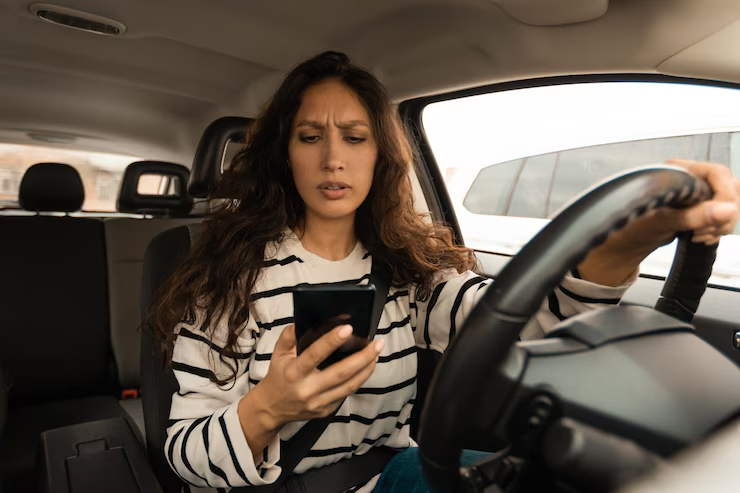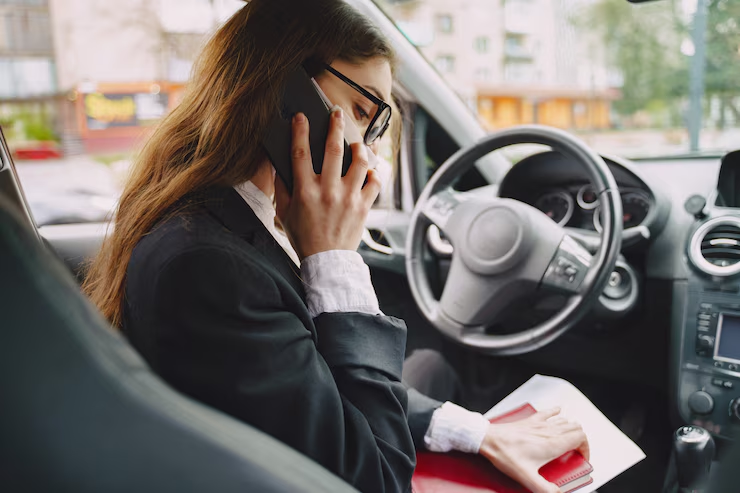introduction
It takes complete focus, fast decision-making, and constant coordination of visual, physical, and cognitive abilities to drive. Avoiding Distractions Tips for Focused Driving. Distractions are regrettably one of the main reasons for traffic accidents all around the world. A chatty passenger or a humming smartphone are two examples.
Road traffic crashes claim the lives of more than 1.3 million people annually according to the World Health Organization (WHO).Driver inattention accounts for a substantial percentage of these collisions.The three main components of safe driving judgment, situational awareness, and reaction time are all compromised by distractions.
The different kinds of distractions that drivers encounter, the repercussions of distracted driving, and thorough, useful advice for maintaining concentration while driving will all be covered in this article.
Recognizing the Distractions That Drive
Three primary categories of distractions exist
- Visual Diversion Distracting yourself from the road
- Distractions by Hand Removing your hands from the wheel
- Cognitive Diversion Distracting yourself from driving
Multiple categories are involved in some distractions.For instance texting and driving is quite risky since it involves visual (reading the screen), manual (typing) and cognitive (thinking about the message) components.
The following are a few typical sources of distraction
- Use of mobile phones (texts, calls, and notifications)
- Consuming food and beverages
- Changing the GPS or radio
- Speaking with travelers
- Fatigue or daydreaming
- Distractions from outside sources (billboards, other accidents, scenery).
The Dangers of Distracted Driving and Its Effects

The danger of accidents is greatly increased when driving while distracted.Driving the length of a football field with your eyes closed is equivalent to taking a five-second break from the road at 55 mph.Anything could happen during that time such as a car braking suddenly, a person crossing the street, or you slipping into a different lane.
Distracted driving has the following consequences:
- Traffic incidents and injuries
- Deaths
- Legal repercussions (penalties, license suspension, and incarceration)
- Increased rates for insurance
- Financial loss and damage to the vehicle
Tips
Store Your Phone
Among the most prevalent and harmful distractions for drivers are cell phones.Driving while texting making calls browsing social media or using apps might cause you to lose concentration at crucial times.
Solutions
- Before you set out on your trip turn off or put your phone on quiet.
- Make use of “Do Not Disturb While Driving”
- Keep the phone out of reach such as in the rear seat or glove box.
- If you have to use your phone stop safely.
Nowadays most smartphones come with built in features and apps that cut down on using phones while driving. Utilize them to avoid temptation and maintain focus.
Plan Ahead Before Driving
Much distraction occurs when drivers try to multitask on the road.Planning your route adjusting settings, or organizing your vehicle before driving helps avoid the need for mid drive adjustments.
Before hitting the road do the following
- Enter your destination into your GPS
- Set your music, radio, or podcast
- Adjust mirrors and seat position
- Secure loose items in the car
- Make important calls or send necessary messages beforehand
- Starting your journey with everything in place allows you to keep your full attention on the road.
Avoid Eating and Drinking While Driving

Grabbing a snack or drink on the go may seem harmless but it often requires taking your hands off the wheel and eyes off the road.Spills packaging and even chewing can become unexpected distractions.
The things to do
- Eat before or after driving.
- If necessary, park safely to eat.
- Choose spill-proof containers if drinking is essential during long drives.
- It’s always better to be slightly delayed than to compromise your safety.
Manage Passengers Wisely
Conversations with passengers can be distracting especially for young or inexperienced drivers.Children and pets in particular can be unpredictable and require extra attention.
Tips for managing passengers
- Set clear expectations with talkative passengers to minimize distractions
- Ensure children are safely secured in car seats.
- Use child locks and backseat entertainment to reduce fussing.
- Secure pets in travel carriers or harnesses.
- The more peaceful and organized the cabin is the less distracted you’ll be.
Avoid being sleepy or emotionally distraction while driving.
Strong emotions like stress, anger or despair as well as fatigue can impair judgment and slow down reaction times.In many cases driving when sleepy is just as dangerous as driving while intoxicated.
Warning signs of fatigue include:
- Yawning frequently
- Drifting between lanes
- Difficulty remembering the last few miles
Solutions
- Get sufficient sleep before long drives
- Take breaks every 2 hours or 100 miles
- Share driving duties on road trips
Limit In Vehicle Technology Use
While modern vehicles come equipped with infotainment systems, touchscreens and digital dashboards these conveniences can become distractions if overused or used improperly.
Tips for safe tech usage
- Use voice controls or steering wheel buttons when available.
- Learn system functions before driving.
- Disable or silence non essential notifications.
- Avoid using the touchscreen while the vehicle is in motion.
- If a system is too complex to use without taking your attention off the road wait until you’re stopped.
Stay Mentally Present
Even when your hands and eyes are on the task your mind can still wander.Cognitive distractions such as daydreaming, replaying conversations or thinking about work can reduce focus.
Stay mentally engaged
Keep the cabin environment calm and minimal.
Being mentally present helps you to make better driving decisions and respond quicker to unexpected hazards.
Use Safety Features as Support Not Substitutes
Many modern cars have advanced driver assistance systems (ADAS) like lane departure warnings collision avoidance and adaptive cruise control.These features enhance safety but should not replace driver attention.
Use these tools properly
- Read the owner’s manual to understand limitations.
- Don’t rely solely on automation — always stay alert.
- Treat them as backups, not replacements.
- Safety tech is helpful, but human oversight is still essential.
Be Aware of External Distractions
Billboards, road signs, roadside events, and even scenery can divert attention. While looking at your surroundings is natural, avoid prolonged stares or rubbernecking.
Best practices
- Keep your eyes scanning the road ahead.
- Limit gazing at accidents or scenery.
- Focus on traffic patterns and signs relevant to your route.
- Stay curious, but keep your primary focus on safe driving.
Motivate Others to Drive With Focus
Setting a positive example and raising awareness are the first steps in fostering a culture of distracted free driving. Discuss the risks with loved ones and promote healthier behaviors.
Strategies that encourage safe driving:
- If you’re a passenger and you see that the driver is preoccupied, speak out.
- Post instructive material on social media.
- Establish family guidelines on teen drivers’ use of phones and distractions.
- To keep an eye on driving behavior, use driving contracts or applications.
- Being proactive raises everyone’s awareness of the dangers.
The Function of Law Enforcement
Laws have been put in place by governments all around the world to prevent distracted driving, especially when using a mobile phone. In extreme circumstances, fines, license suspensions, and even jail time may be imposed.
Typical legal actions consist of
- Bans on handheld phones.
- Texting while driving laws.
- Graduated licensing programs with distraction restrictions for new drivers.
Enforcement and education go hand in hand. Many countries are investing in awareness campaigns and police enforcement strategies to reduce the risk of distraction-related crashes.
Developing Better Habits Over Time
Avoiding distractions is ultimately a matter of developing habits. Just like learning how to drive safely, staying focused behind the wheel becomes easier with practice and intention.
Start by:
- Identifying your biggest distraction triggers
- Replacing bad habits with safer routines
- Holding yourself accountable for slip-ups
- Celebrating progress and safer trips
With time, staying focused becomes second nature.
conclusion
Driving when distracted is avoidable.Numerous lives are lost or irrevocably changed each year as a result of drivers’ careless moments. Distractions impair your ability to drive safely, whether it’s a fleeting look at your phone or an intense chat.
You can become a more responsible and focused driver by identifying the many kinds of distractions, comprehending their effects and heeding the helpful advice provided in this article.Everyone will profit greatly from safer roads, fewer accidents and increased peace of mind.
Never forget that your life or someone else’s life is more valuable than any text message,snack or discussion.Make concentration your first priority when driving

